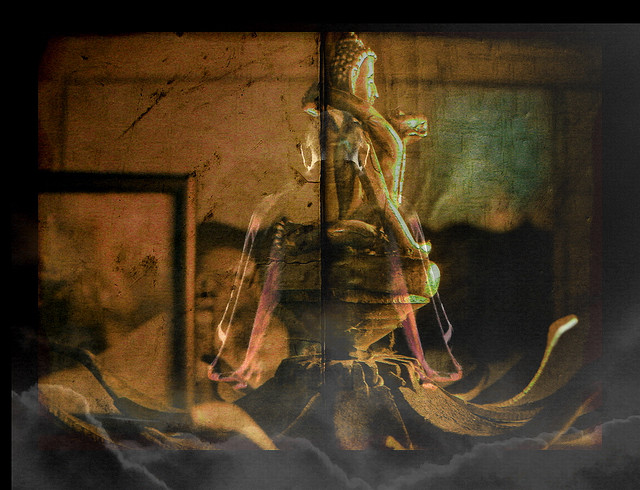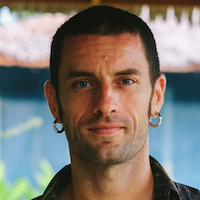
When you hear the word “Tantra,” you probably think about two things: sex and spirituality.
The original meaning of Tantra (literally “warp”or “web”) refers to a complex system of beliefs and practices arising in India around the 5th-6th century A.D.
What makes Tantra novel and different from other spiritual traditions is that it is, first and foremost, a holistic approach to life and spirituality. The word “warp” itself implies that everything in the Universe is interwoven and interconnected.
In Tantra, the manifested world that we can perceive with the five senses deserves the same degree of respect and adoration as its counterpart: the Spirit or Consciousness. As a consequence, anything and everything is a potential source of spiritual evolution: food, music, medicine, astrology and of course, sexuality and carnal love. This integral, holistic approach is the basis of many of the characteristics of Tantra, such as its emphasis on the physical body and on sexuality.
In Tantra, the human body is considered both a holographic representation of the whole Universe, and a receptacle in which hidden, enormous forces lay dormant. Through the correct use of the body, we can not only live a healthy and long life, but also unlock the mysteries of the Universe. The study of the physical body from this new perspective gave rise to the well-known system of chakras (energy nodes) and nadis (energy channels) that lies at the base of Hatha Yoga, the Yoga of asanas (physical postures) and pranayama (energy control through breathing patterns).
The role of the body as a sacred manifestation of Shakti (Energy) also explains the connection between Tantra and sexuality. Tantra acknowledges that sexual energy is the most powerful form of energy in the human being; but since Energy and Spirit are two sides of the same coin, one can be accessed through the other. As a consequence, sexuality, if used correctly, can be not only pleasurable, but also an important tool for spiritual evolution.
This is why Tantra offers so many tools to awaken, channel and control the sexual energy: it is simply something too valuable to be wasted.
Because of this positive approach to sexuality, intimate relationships abound within the communities that develop around a Tantric teacher and school. Students of Tantra sooner or later usually start experimenting with sexuality and including intimate relationships in their sadhana (spiritual practice). This creates some specific challenges that wouldn’t be relevant in a monastic, non-sexual spiritual environment. One of the main questions that comes up is the issue of monogamy versus open relationships (i.e. having multiple lovers). What are the models to follow, if we consider intimate relationships as part of a spiritual practice?
There is a general perception that, in modern Tantric schools, open relationships are encouraged over monogamous relationships. This is not entirely correct, but it does have a basis of truth. Although it includes relationships and sexuality into spiritual practice, Tantra is not concerned with the established morality or social conventions of the time. Monogamy, from the standpoint of Tantra, is just one of the possible configurations. In other words, within Tantric communities monogamy loses its privileged status of “the right way to do things,” and it becomes just one choice among others.
This explains why people that come to Tantric schools with the idea that monogamy is the only way to have meaningful, deep relationships usually face some challenges. There are many cultural devices that protect monogamy in most of our cultures, but they don’t necessarily hold within a Tantric environment. For example, people in a Tantric community generally do not consider a man or woman “off limits” just because he or she is in an intimate relationship with someone else.
In this sense, open relationships are indeed more prevalent in Tantric communities than in the world “out there,” where these options are often relegated to silence.
But now it is time to look at the other half of the story. It’s true that Tantra does not consider monogamy a privileged choice—but it does not deny it either. Tantra does not explicitly endorse monogamy, nor does it uphold open relationships per se. This non-exclusive stance is just a reflection of the fundamental Tantric attitude: “anything goes, as long as it serves your spiritual evolution.”
The Vijñāna Bhairava Tantra, one of the fundamental Tantric texts, lists 112 meditation techniques that can bring a practitioner to spiritual realization. Some of them are as unconventional as concentrating on sneezing, inducing dizziness, or focusing on a delicious taste! The underlying assumption is that a meditation technique is just a device: the objective of all meditation is the same, and it cannot be described, as it is beyond mind and language.
Tantra does not place a huge emphasis on techniques and practices: it considers them just tools. Find the tool that works for you, and then use it, is the Tantric message.
In the context of intimacy and love, this means that any form of relationship can work towards spiritual evolution. Monogamy, polyamory, group marriage, celibacy—all are valid options for the Tantric practitioner. It does not really matter which one he or she chooses, but rather whether he or she can use it as a tool for spiritual realization. Tantra gives important guidelines to help transform a sexual, intimate relationship into spiritual practice.
Although this goes beyond the scope of this article, the two main factors are transfiguration and brahmacharya (sexual continence). If these two guidelines are observed, then an intimate relationship can be a wonderful Tantric practice, whether monogamous or not.
Summing up, Tantra by itself does not favor either monogamous or non-monogamous relationships. It is true that Tantra does not tribute a special status to monogamy, which explains the perception that, in Tantric communities, non-monogamous relationships have a higher status than elsewhere. In reality, from the Tantric standpoint both monogamy and open relationships can co-exist, along with other choices.
The practitioner that decides to embark on the journey of Tantra will find a huge array of possibilities before him or her. In Tantra, anything and everything is a potential tool; what really matters is our state of consciousness.
Tantra is a “broad path” that does not set rigid limits on the sadhana. Rather, it aims to develop a state of awareness and consciousness from which everything becomes spiritual practice.
Relephant:
Yoga, Monogamy & Polyamory.
Tantric Celibacy: Radical Self-Loving.
Author: Raffaello Manacorda
Editor: Renée Picard
Image: Spirit of Tantra by Hartwig HKD at Flickr


Read 2 comments and reply